Point of Ayr – November 2010 – Report by Sue Brealey – Photo by Jim Almond
At about 8.30am, a total of eight members arrived at Talacre in North Wales, in time for the high tide, due at 10.25. The weather was good with initial clear skies, although we had to endure quite a heavy shower mid morning.
Whilst in the car park, we spotted three separate flocks of Golden Plover flying over, as well as a group of Long tailed Tits flying around. As we headed off to the Point, we had superb views of a Kingfisher in branches above a small pool next to the path. Plenty of Skylark, Linnets, Little Egret and waders were on the move as we arrived at the best viewing point (the site of the original hide).
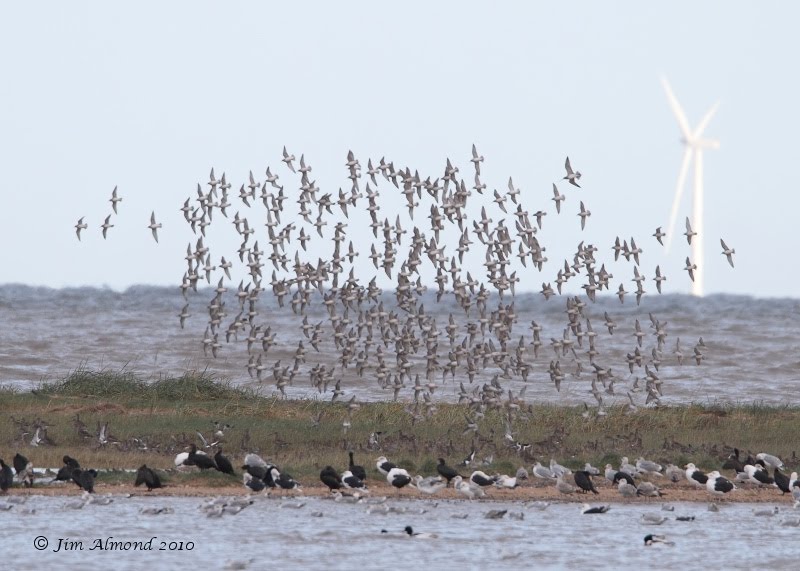
Knot, Point of Ayr
The distant Point appeared to be black with birds, with Oystercatcher, Cormorant, Great Black-backed Gull in huge numbers. We could also see plenty of Black tailed Godwit, Curlew a few Dunlin, with good numbers of Redshank much nearer. Two Grey Plover were noticed in the distance. On the far side of the Point there must have been a settled flock of at least 1,000 Knot, and every so often, these would fly up with the Godwits and Redshank giving a stunning aerial display. On the water were plenty of Shelduck, Wigeon, Pintail, Teal and Mallard together with three Red breasted Mergansers. A ringtail Hen Harrier flew in, causing panic amongst the waders and dropping on a kill, it later flew up, circled the point before heading off up the Dee Estuary.
We added Greenshank with plenty of Meadow Pipit and other common birds on view as we headed back for a break and very good bacon baps!! Quite a few Common Gulls were seen as we walked through the dunes for a brief sea watch, which sadly produced little of note..
At about 1.30, the main party decided to head for RSPB Inner Marsh Farm. The journey of about 35 minutes was interrupted as we stopped to scan a group of Mute Swans in a field. After parking safely in a field gateway, we could see there were some Whooper Swans amongst the flock. The feeder station at Inner Marsh Farm held plenty of Blue Tit, Great Tit, Chaffinch, Coal Tit, Goldfinch and Nuthatch. The walk down to the hide was pleasant with lovely views over the surrounding countryside, and along the way a Kestrel was seen.
From the hide, we could see a group of Lapwing with eight Golden Plover, beautifully lit up in the sunshine. On the water were good numbers of Teal, Shoveler, Wigeon and some Pintail plus a flock of Greylag Geese, with some Curlew at the back of the reserve under trees. A Grey Heron was moving around the nearest pool to the hide looking for food but not really managing to catch much! By 3.30 and with the light beginning to fade, we decided to head back to the car and travel home. It had been an excellent day’s birding, highlighted by the magnificent aerial wader display plus chasing Hen Harrier.
Norfolk Weekend – October 2010 – Report by Joyce Jones & Jim Almond – Photos by Jim Almond & Yvonne C
The week-end trip to Norfolk was based in Sheringham but most birders find it difficult to pass Titchwell on the way and quite a few of the party stopped here on the Friday en-route! The reserve is a sorry sight at the moment due to the alterations made necessary by the encroaching North Sea. However, there is still much of interest to be seen. The Marsh Harriers are still there and plenty of duck species and on the sea we found Great-crested Grebe, Red-throated Diver and Common Scoter. With the autumn migration in full swing there was a constant flow of birds coming in off the sea. It was fascinating to watch how some, like the Redwings flew in very high and carried on over the reserve while others only just made it over the sea wall and dropped like stones into the salt marsh scrub. Some did not even make it that far as they fell victim to the Gulls and a Peregrine patrolling just off shore. There were other species such as Swallows and Wheatears intent on their own migration in an entirely different direction.
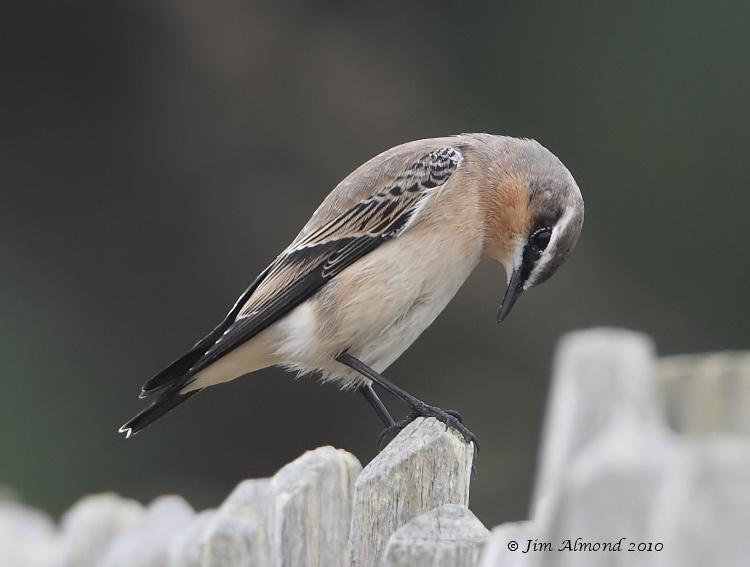
Other members of the party began to arrive by lunchtime and after a leisurely picnic we set off for Wells. A short walk in the woods where Andy found a Firecrest and several Goldcrest. We then had to make our way to the accommodation which was a very pleasant B&B in Sheringham with time for a wash and brush up before joining the other members for a lovely evening meal.
On Saturday it was decided to go to Holkham Gap – a good place to look for Shore Lark in the dunes. From Lady Anne’s Drive we had good views of Redstarts and Jays but then things went a bit awry! The tide had not retreated sufficiently and our walk to the dunes was ultimately abandoned due to deep water filled channels! There were lots of riders enjoying a gallop through the shallow water. Unfortunately one young rider lost control of her mount when the horse was spooked by barking dogs, she was unseated as the horse bolted. Fortunately she was not injured and the horse was caught by other riders.
All self respecting birds had left the area by now, so we walked back through the woods and found only the usual woodland species. However, we did encounter a group of mycologists from Cambridge who were doing an annual survey of the fungi on the reserve. They had collected an amazing variety of fungi and were very willing to share their knowledge with us. Our next stop along the coast was the Holme NNT Reserve, where a juvenile Harrier, initially presumed to be Montagu’s Harrier was spotted on arrival. This bird is now being considered by the BBRC as a probable Pallid Harrier.
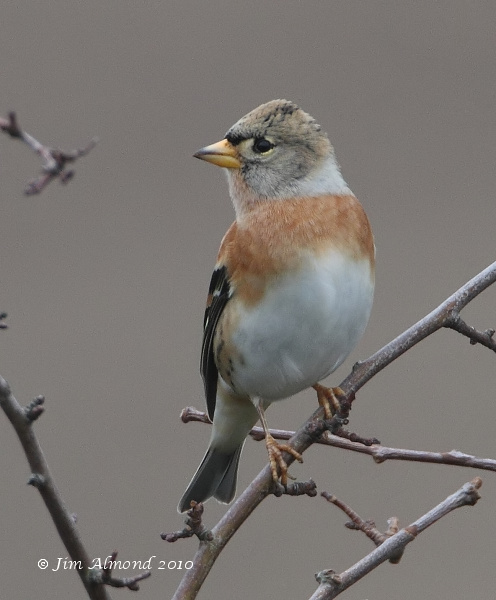 Brambling, Walsey Hills |
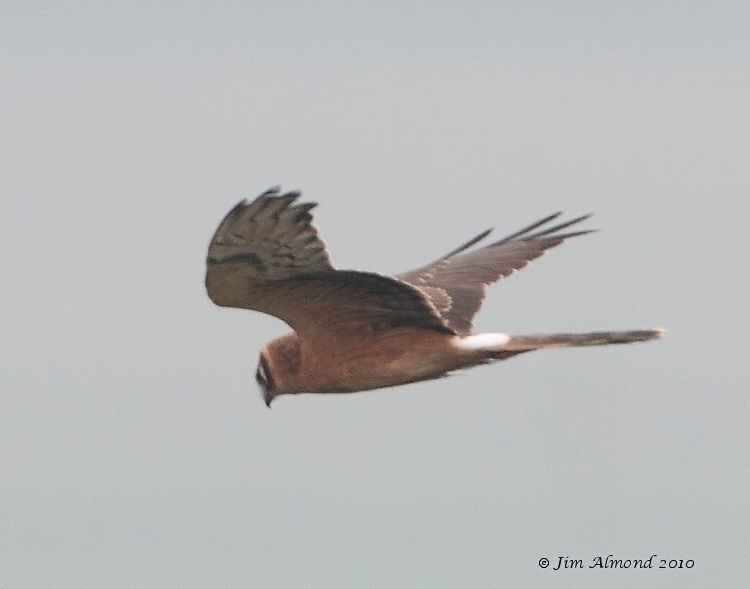 Pallid Harrier, Holme |
More photographs of this bird were recorded by Jim and can be seen at http://shropshirebirder.blogspot.com
After lunch we made the trek out along the dunes at Holme where we were rewarded with a Yellow-browed Warbler. The little bird was very obliging and showed well in a bramble bush, but only one sharp eyed member of the group managed to see the Wryneck which was close by. We had to leave when the warden came to close the reserve but it was time to head back to get ready for another jolly evening of food and wine and tall tales.
We all woke up to a beautiful warm sunny Sunday morning and with the wind in the wrong direction, an early morning seawatch did not produce anything of note although Andy found a Ring Ouzel nearby. After a hearty breakfast we all set off for Cley. The walk along the East bank treated us to an amazing display of Bearded Reedlings. Family parties were calling and flying very close to the path and no one could remember ever seeing such numbers. Serious migration was still going on and as we looked up to see a party of Bramblings overhead, Estelle spotted a raptor which proved to be a Merlin trying his luck over the reed beds. He gave a wonderful display of aerial acrobatics for several minutes before flying off inland. Six White-fronted Geese were in the area and these were seen flying overhead by some of the party.
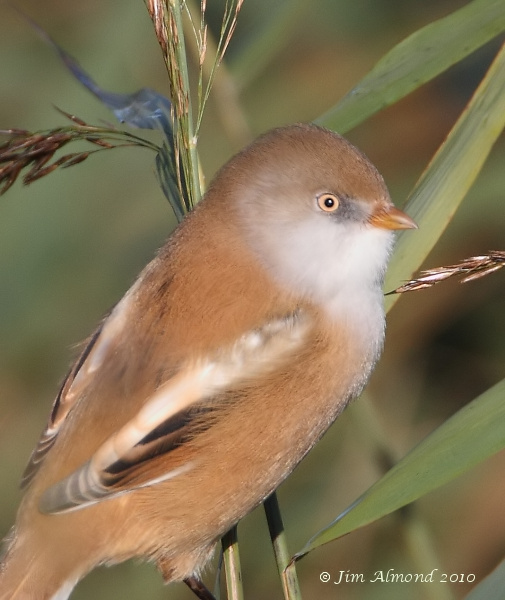 Juvenile Bearded Tit, East bank at Cley |
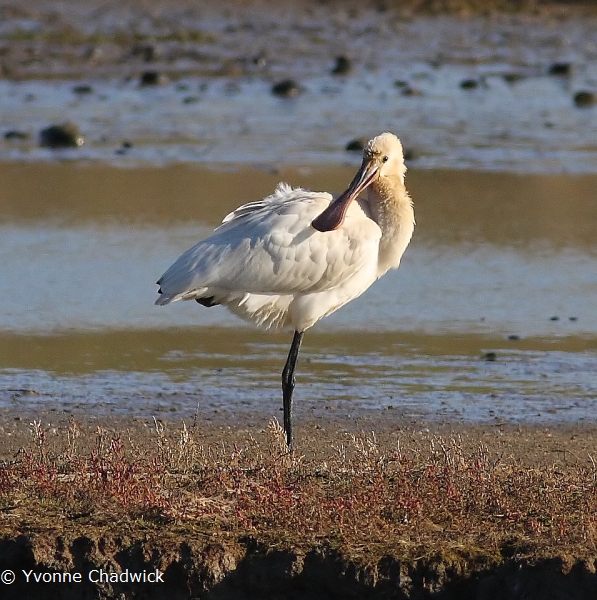 Spoonbill, East Bank at Cley |
We eventually caught up with the Shore Larks on the shingle bank and then had really close views of a Spoonbill on Arnold’s Marsh. There were a good number of wader species seen here including: Spotted Redshank, Common Redshank, Bar-tailed and Black-tailed Godwit, Dunlin, Ringed Plover, Grey Plover and a Curlew Sandpiper! Two male and two female Ruff were feeding together, giving a good appreciation of the size difference between the sexes. We went to Wells for lunch and another walk through the woods before calling it a day. Among the 97 species recorded, some members had seen more than one life ticks which is always very satisfying for birders and so ended another very successful SOS week-end trip and we the organisers were thanked for ensuring everyone all had a wonderful time and saw plenty of birds.
There were some additional moments of great birds, enjoyed by individuals both before and after the ‘official’ trip. After heading to Minsmere on the Friday, where the long staying King Eider duly obliged, Ron decided late on the Sunday to embark on the mile long trek through mud and water at East Hills to be rewarded with an Olive-backed Pipit – both birds lifers for him. The Monday had more good birds in store for Jim and Yvonne with a twitch at Burnham Overy where a long trek to the dunes culminated in amazing views of Pallas’s Warbler! A breathtaking ten minutes followed as a Red-flanked Bluetail was found literally 50m away. Norfolk may not always produce the birds where and when you want them but during October at the peak of migration, there is always likely to be a surprise in store!
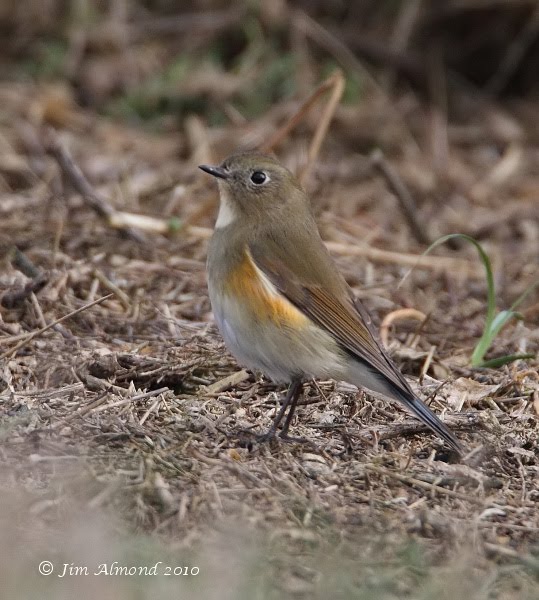 Red-flanked Bluetail, Burnham Overy |
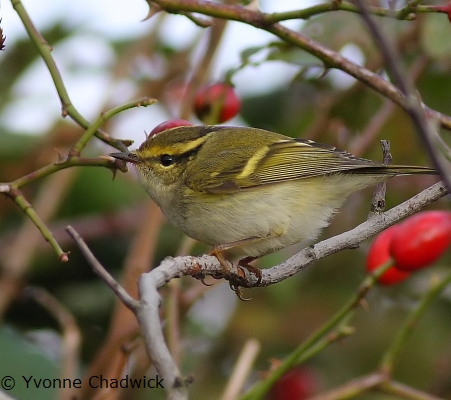 Pallas’s Warbler, Burnham Overy |
Brandon Marsh – September 2010 – Report Estelle Hughes
Four of us met at Brandon Marshes, a SSSI site 2k SE of Coventry, owned by Warwickshire Wildlife Trust. Removal of coal followed by sand and gravel has created a network of marshy areas and pools, shared by fishermen and nature lovers. The dry areas have been planted with many trees and berry-bearing shrubs – a haven for birds and insects on a sunny day. Unfortunately, we had to contend with grey cloud and two prolonged showers which we managed to avoid by spending time in the various hides which were only a small distance apart.
Despite the weather we managed to see or hear 47 species and highlights were superb views of Kingfisher, obligingly sitting for several minutes in front of us and affording wonderful opportunities for photographers. A Green Sandpiper was equally obliging, and a pair of Mute Swans which repeatedly chased and finally saw off a lone male. The cob covered some distances, creating bow waves as it swam across what was the biggest pool to give chase, it was interesting behaviour to watch.
From the main East hide we saw a flock of some 300 Lapwing, a large number of Greylag Geese but few Canada geese. There were and numbers of Common Teal, Mallard, Coot and Moorhen, but only one or two pairs of Tufted Duck, Gadwall and Wigeon. Common Snipe were present, Grey Heron, including two juveniles and Great-crested Grebe but no Dabchick.
We had a fleeting glimpse of a Green Woodpecker and repeated views of Great-spotted Woodpecker and heard noisy Jays. Great Tit, Blue Tit and Long-tailed Tits flitted through the trees and we had a Nuthatch at the feeder station, but missed seeing the Bullfinches previously been seen there. Whilst in the car park, there were plenty of common birds including: Greenfinch, Goldfinch and Chaffinch, Linnet, Swallow, Robin, Magpie and an overflying Cormorant. Surprisingly we had no Thrush, Blackbird or Dunnock at all.
One or two dragonflies braved the elements and between showers, we had good views of a vibrant Migrant Hawker, a Common Hawker and mating Common Darter.
An enjoyable day was rounded off by tea and cake at the very comfortable and neatly laid out refreshment area before making our way home.
Cotswold Water Park – June 2010 – Report by Helen Griffiths
A small group of five members (travelling together in one vehicle) made an early start from Shropshire for our visit to the Cotswold Water Park, where two others, on holiday in the Cotswolds, joined us for the day. The Cotswold Water Park, on the border of Gloucestershire and Wiltshire, covers 40 square miles, and has over 140 lakes, in two sections, eastern and western. These lakes formed as a result of gravel extraction; many have been restored and are now used for watersports, for angling, or for wildlife.
Our destination for the day was the western section; we met at the Gateway Visitor Centre and began a leisurely day’s birding, well fuelled following our bacon sandwiches and coffee!
Our first stop was the car park at Clayhill, in the centre of the western section of the Water Park. Our walk, of about three hours, took us along elder and hawthorn-lined footpaths and a cycle track, around several lagoons, and although the species list for the day was not huge, we had a number of very good views of common birds. Plenty of Warblers were in evidence but not in great numbers, and we failed to hear Nightingale (possibly a little late in the season for them to be singing). However, we did see and hear Garden Warbler, Chiffchaff, Blackcap, Sedge and Reed warblers. We were able to compare the songs of Common and Lesser Whitethroats, when both were singing together from the top of the same hedge. We heard a Cuckoo, singing from the middle of an oak tree in the distance, a very welcome sound this year when they have been scarce in many places, including Shropshire. A couple of Hobbies, hawking for dragonflies, were seen, but we were surprised not to see more. Only four Swifts were seen during the day, and there were very few hirundines about. There was a Common Tern over one of the lagoons, as well as plenty of Black-headed Gulls, and Great-crested Grebes. One of the highlights of the day was probably the female Red-headed Pochard with a brood of seven recently-hatched ducklings. The total for the day was only around 50 species, but it was a very enjoyable walk, and there was plenty of time for botanising and looking for and photographing butterflies too.
After a late lunch, we drove to the Wiltshire Wildlife Trust car park at Lower Moor Farm, where we spent some time watching the dragonflies and damselflies at some small, recently-created ponds at the site. The ponds were developing well and we were able to have excellent views of, and photograph, seven species – Common Blue Damselfly, Emperor Dragonfly, Four-spotted Chaser, Blue-tailed Damselfly, Red-eyed Damselfly, Black-tailed Skimmer and Broad-bodied Chaser.
At the end of our visit there was just time to call at the Gateway Centre again, this time for ice creams and a quick look in the Cotswold Outdoor Shop, before setting off for home after a very enjoyable and relaxing day. En route, we decided to make a short diversion to Upton Warren in Worcestershire, where a very smart, female Red-necked Phalarope in summer plumage was on view.
Thanks to Andy Latham for agreeing to lead this trip and as ever, for sharing his expertise with us, and to Sue Brealey for being the chauffeur for the day.
Dawn Chorus on the Wrekin – 15 May 2010 – Report by Richard Camp
About ten early risers made it to the bottom of the Wrekin by 5am to hear the wonder of the Dawn Chorus and have some difficult birds identified by song. A learning exercise for most of us. The leader was Alan Heath so we knew from the start that songs would be expertly identified. Andy Latham was also in attendance and his local knowledge of the Wrekin woods and the places where certain birds hang out was invaluable.
We started a slow walk along the bottom path, going past the sharp right turning which goes up to the Wrekin summit, and going as far as just past the pig sty ruins by a gate on the left. We soon picked out the more common birds such as Blue Tits, Great Tits, Blackbirds, Robins, etc. A known Marsh Tit nest hole enabled us to add this species to our list. Our first ‘target’ species was a Pied Flycatcher. Then, with our expert help, Garden Warbler and Wood Warbler were picked out. Two very difficult species for most of us.
Retracing out steps, we then took the path to the summit, adding Jay, Wren, Dunnock and Nuthatch to our list on the way. In the bushes by Halfway House we saw male and female Bullfinches – surely nesting nearby. What a beautiful bird is the male Bullfinch with its red front, black head and white rump.
Towards the top we added Willow Warbler, Tree Pipit, Blackcap and Meadow Pipit to the list and on the way down we saw a number of Long-tailed Tits. The number of species seen by the group members varied but the writer recorded 20. The trip was well worth going on for the difficult species.
Afterwards, a well deserved traditional English breakfast was enjoyed at Platelayer’s Café on Wellington Station. Some also went on to Venus Pool.
Rutland Water – 18 April 2010 – Report by Sue Brealey
On a rather misty morning a group of 28 members gathered at Shirehall, and started the journey to Rutland Water at 7.30. The weather improved during the journey and on arrival at 10.30, it proved to be clear and sunny, if a bit cool.
The visitor centre established that the Ospreys present were better viewed from the Lyndon area. After some discussion it was decided to explore the Egleton area during the morning and at about 1 o’clock, drive around to the Lyndon area for the afternoon. We split up into various groups.
An initial stop at the feeding station where Tits, Chaffinch, Greenfinch and Tree Sparrow were noted. Going towards the new Lagoon 4, the group saw a Sparrowhawk fly over, and then noted Blackcap, Sedge Warbler and Willow Warbler in the hedges and reeds along the path. A stop at the Redshank hide, where the light was very much in our faces at that time of day produced Canada Goose, Greylag Goose, Mute Swan, Black-headed gulls, Mallard, Tufted Duck, Gadwall, Shelduck, Cormorant and Great Crested Grebe. Common Tern and Egyptian Goose were also seen. We moved on to the new Dunlin Hide overlooking Lagoon 4, a new asset where the vegetation needs to grow but the potential was clear to see. We saw Dunlin, Ringed Plover, Little Ringed Plover, Oystercatcher, Green Sandpiper, Wigeon and Teal. Some of the party witnessed an Osprey fly in and catch a fish!
After a pleasant walk back, visiting various other hides en route, we assembled in the car park to travel over to the Lyndon area. The coach had to stay at the entrance and we had a good walk down a fairly steep hill to the centre enjoying lovely views overlooking the reserve on our way.
Following advice, we went to the Waderscape and Shallow Water hides to view the Ospreys. We had very good views of the birds on a nest and nearby pole. The eggs had yet to be laid and the volunteers had built a shed near the Shallow Water hide and were insulating it in order to comfortably accommodate volunteers, ensuring a 24/7 watch during the breeding season. It was really good to see these fantastic birds doing so well in an English setting.
A large group of Sand Martin came and rested on the wire fence over the water and displayed wonderfully, flying off and coming back several times, a lovely spectacle. Other birds seen included Chiffchaff, Swallow and Pied Wagtail. It had been agreed to start back at about 4.15, so the group trekked back up the hill to be back at the coach in good time. It was a good journey back except for a bit of a delay on the M6, we arrived back in Shrewsbury at about 7pm after a really good day’s birding. We really did not do the reserve justice as it is so large.
My thanks to Dave Barrow, Roger Gibb and Toni Gordon, who have contributed their combined list for the day below.
Great Crested Grebe – Cormorant – Grey Heron – Mute Swan – Greylag Goose – Canada Goose – Egyptian Goose – Shelduck – Wigeon – Gadwall – Teal – Mallard – Pochard – Tufted Duck – Red Kite – Buzzard – Osprey – Kestrel – Pheasant – Water Rail – Moorhen – Coot – Oystercatcher – Little Ringed Plover – Ringed Plover – Lapwing – Dunlin – Curlew – Redshank – Black Headed Gull – Common Gull – Lesser Black-backed Gull – Herring Gull – Greater Black-backed Gull – Common Tern – Stock Dove – Woodpigeon – Collared Dove – Skylark – Sand Martin – Yellow Wagtail – Pied Wagtail – Wren – Dunnock – Robin – Blackbird – Song Thrush – Cetti’s Warbler – Sedge Warbler – Blackcap – Chiffchaff – Willow Warbler – Long-tailed Tit – Blue Tit – Great Tit – Magpie – Jackdaw – Rook – Carrion Crow – Tree Sparrow – Chaffinch – Greenfinch – Goldfinch – Reed Bunting – Australian shelduck cross – Goldeneye – Green Sandpiper – Linnet – Little Grebe – Swallow – House Sparrow – Bullfinch – Sparrow Hawk – Little Gull – Lesser Whitethroat
75 Species (Skylark, Curlew and Wren included on song only: not actually seen)
Leighton Moss – 21 March 2010 – Report by Sue Brealey Photos by Jim Almond
A group of six people later joined by two more arrived at the venue for about 10am, having driven by car. The journey was good but on arrival the cloud cover increased, and there was a chilly wind. The reserve was busy with two coach trips coming on the same day.
The group started by going to the Eric Morecombe and Allen Hides. There were large numbers of Redshank & Black tailed Godwit seen from the Eric Morecambe hide although the light was very flat. One birdwatcher mentioned that there could be a Spotted Redshank, but the light precluded identifying it. Amongst other birds were Pintail, Teal, Wigeon, Avocet (six), Lapwing, Oystercatcher, and Curlew. A distant view of a Peregrine was enjoyed by all but identification in the heat haze was not that easy. A Chiffchaff was seen near the Allen hide, and on the way back to the Visitor Centre a group of three Snow Geese were noted in a group of Greylag and Canada Geese.
 Avocets |
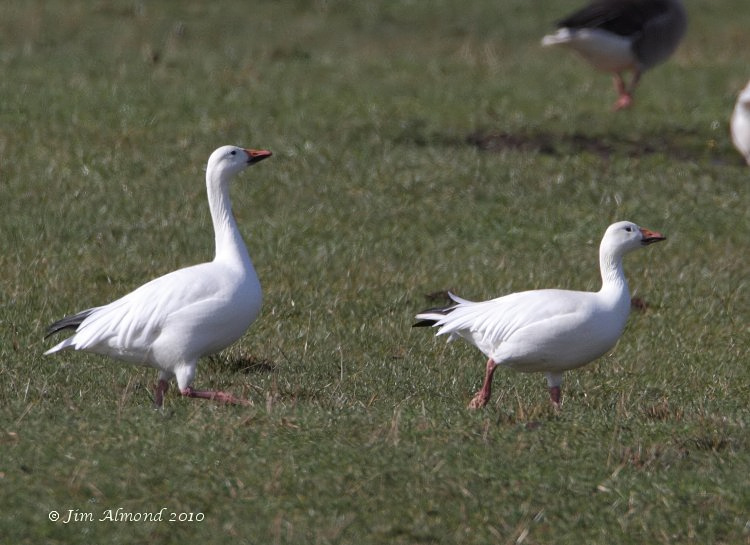 Snow Geese |
The group decided to go to the Causeway. On the way, a stop at the feeding station found Great Tit and Blue Tit, Chaffinch, Greenfinch, Bullfinch, & female Pheasant. On arrival at the Public hide, the group had lunch, while looking out on lots of Black headed Gulls displaying for the breeding season, together with a great many Coots. A Pair of Great Black backed Gull were present, as well as Great crested Grebe, Common Gull, Cormorant and Pochard. A Buzzard flew over distant trees. There was no sign of Kingfisher, Bearded Tit or Bittern. A walk to the further Lower hide found Marsh Tit and Treecreeper in the trees. Other birdwatchers reported Goldcrest, and Redpoll here but they proved to be proved elusive. The Lower hide didn’t really show anything of real interest.
A return to Lillian’s hide found more Black headed Gulls, plus a very well camouflaged Common Snipe, plus several ducks including Goldeneye, although this wasn’t seen by all. A move to Griesdale hide, proved productive including very good views of a Peregrine in a tree and amongst the Teal a Green winged Teal showing its vertical white marking by the shoulder. Amongst the ducks were Gadwall, Shoveller, Tufted Duck, Mallard (aggressively mating!), a Grey Heron flew in and then up to 7 Little Egrets were seen. A few Sand Martin were seen flying over the reeds.
 Green-winged Teal |
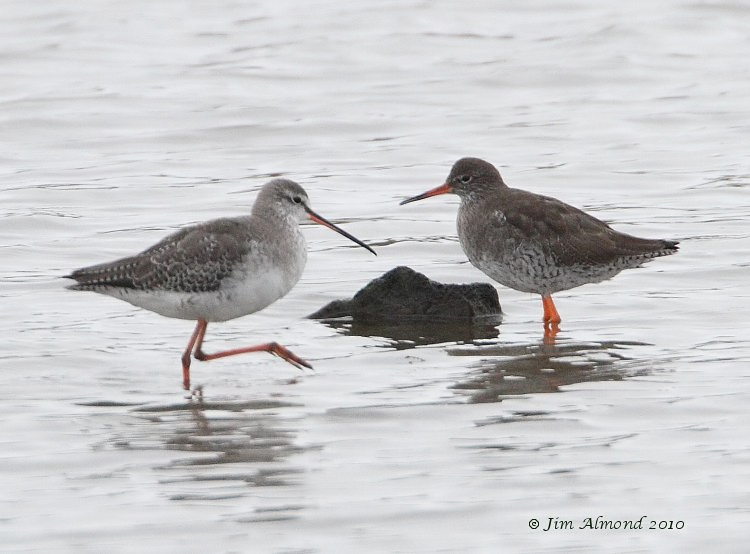 Spotted (left) and Common Redshank |
It was decided to return to the Eric Morecambe and Allen hides, now that the light direction had changed. Once there, the group was rewarded with very good views of a Redshank, a Spotted Redshank and a Greenshank all feeding very closely together. They could be seen easily through the scope and it was educational to see the differences in shape, bill and plumage of the Greenshank, Common Redshank and Spotted Redshank. After a bit more scanning, we capped the icing on a really good day, a Merlin, perched on a post which then flew to another nearby post enabling very good views.
It was now nearly 5pm, and with a long drive home, it was decided to call it a day on what had proved a really enjoyable and productive day’s bird watching, which included a list of between 50 and 55 amongst the group.
RSPB Middleton Lakes – 7 February 2010 – Report by Sue Brealey
At about 10am, twelve members of the Society, including 3 new to Field Trips, turned up at Middleton Hall, near Tamworth to see this new reserve, at present restricted from the public. The weather was dry but overcast, with a light wind but feeling rather chilly. Following recent serious winter weather conditions the conditions underfoot were muddy to say the least. Wellington boots or walking boots were definitely the order of the day.
Two volunteers, Sue Walker & David Ball, had agreed to show us around and proved to be very knowledgable. In the car park the group had very good views of a Common Buzzard looking for worms and a Mistle Thrush singing away in the trees. Initially the group walked down a track toward a farm, and Sue indicated a field where the RSPB are planning to construct an area for car parking, toilet area and areas of interest for children such as pond dipping areas etc. There is funding for this but planning permission is being looked for and until this facility has been built, the RSPB will be reluctant to open the site up to the public.
The group walked through the farmyard and onto a bridleway, passing by a small ancient woodland, which holds a variety of trees, plus a running brook which runs into the nearby River Tame. We were told that during the spring it bursts with bluebells and then wild garlic, and is a home for all the Woodpeckers, plus Kingfishers. We saw a Great spotted Woodpecker fly by and later was drumming away, and were informed that a Lesser spotted Woodpecker had been seen the previous week. The bridleway then passed through an area owned by the Inland Waterways, which passed by the Birmingham & Fazeley canal and then over a bridge to the reserve proper. Along this route, Blue & Great Tit, Robin, Wren & Dunnock were observed.
The initial view was of the southern lakes which are quite extensive. The water levels were very high. We were informed that the 100 or so volunteers had made up a lot of islands in the lakes, at present pretty well buried in water, as well as planting a great area of reed protected by nets at present while they start to cover the lake. Maybe in the future Bittern will be attracted to the area. But present on the lakes were plenty of duck including Mallard, Gadwall, Shoveler, Tufted Duck, Common Teal, Greylag Geese flying over, Canada geese, plus a couple of pairs of Goldeneye and Pochard. The group then went on an anticlockwise track around the area. It was in places very muddy, and Sue indicated that in the past few weeks this had been ankle deep!
As we passed a gateway, we were informed that this field was going to become a meadow area, which had been fenced off to protect it, and was going to be grazed with cattle and ponies from Poland. There were going to be smaller areas within this fenced away which would themselves be fenced in order to observe the effects the grazing was having on the meadow. Survey work was in progress to see how the reserve is progressing. We saw numbered black rubber mats arranged in areas, to look for grass snakes, wooden posts where photographers were regularly recording the area to show visual progress, as well as surveys of the plant life, butterflies etc.
As we progressed further, more lakes could be seen, showing how extensive this 400 acre reserve is. A Kestrel was seen perched in a tree, and later a Little Egret was seen flying in. In a further lake Great crested and Little Grebe were seen in their winter plumage. The River Tame was observed to split the reserve, but the Northern lakes could be seen. The Tame was very high, but the sand banks seen looked very much as if they could be colonised by sand martin. Eventually a bridge will be constructed to bring the two halves together. The group went as far as was feasible, coming to an area where a large deep ditch splits the Southern Lake area. A bridge is proposed to bring the area together.
The group returned the way it had come, and arrived back at the car park around 1pm after a walk covering 4 to 4½ kilometres. Although the bird life was not that spectacular on the day, the conditions were not really there for that. But the potential of this reserve was seen by all. With all the reed beds being planted and other landscape schemes to come, and also the position of the site being between the rivers Avon & Severn to the south and Trent going to the Humber in the north, this natural passageway for wildlife will prove successful in the future.
Many thanks to Sue Walker, David Ball & the staff at RSPB Middleton for their help and future work on the reserve.
